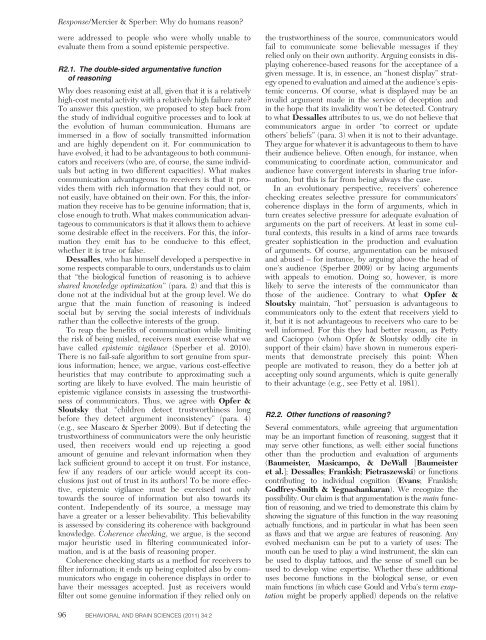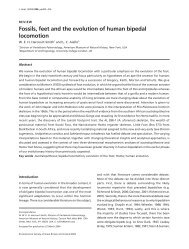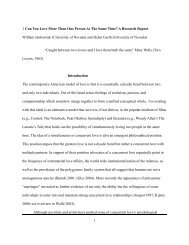Response/Mercier & Sperber: <strong>Why</strong> <strong>do</strong> <strong>hum<strong>an</strong>s</strong> <strong>reason</strong>?were addressed to people who were wholly unable toevaluate them from a sound epistemic perspective.R2.1. The <strong>do</strong>uble-sided <strong>argumentative</strong> functionof <strong>reason</strong>ing<strong>Why</strong> <strong>do</strong>es <strong>reason</strong>ing exist at all, given that it is a relativelyhigh-cost mental activity with a relatively high failure rate?To <strong>an</strong>swer this question, we proposed to step back fromthe study of individual cognitive processes <strong>an</strong>d to look atthe evolution of hum<strong>an</strong> communication. Hum<strong>an</strong>s areimmersed in a flow of socially tr<strong>an</strong>smitted in<strong>for</strong>mation<strong>an</strong>d are highly dependent on it. For communication tohave evolved, it had to be adv<strong>an</strong>tageous to both communicators<strong>an</strong>d receivers (who are, of course, the same individualsbut acting in two different capacities). What makescommunication adv<strong>an</strong>tageous to receivers is that it providesthem with rich in<strong>for</strong>mation that they could not, ornot easily, have obtained on their own. For this, the in<strong>for</strong>mationthey receive has to be genuine in<strong>for</strong>mation; that is,close enough to truth. What makes communication adv<strong>an</strong>tageousto communicators is that it allows them to achievesome desirable effect in the receivers. For this, the in<strong>for</strong>mationthey emit has to be conducive to this effect,whether it is true or false.Dessalles, who has himself developed a perspective insome respects comparable to ours, underst<strong>an</strong>ds us to claimthat “the biological function of <strong>reason</strong>ing is to achieveshared knowledge optimization” (para. 2) <strong>an</strong>d that this is<strong>do</strong>ne not at the individual but at the group level. We <strong>do</strong>argue that the main function of <strong>reason</strong>ing is indeedsocial but by serving the social interests of individualsrather th<strong>an</strong> the collective interests of the group.To reap the benefits of communication while limitingthe risk of being misled, receivers must exercise what wehave called epistemic vigil<strong>an</strong>ce (Sperber et al. 2010).There is no fail-safe algorithm to sort genuine from spuriousin<strong>for</strong>mation; hence, we argue, various cost-effectiveheuristics that may contribute to approximating such asorting are likely to have evolved. The main heuristic ofepistemic vigil<strong>an</strong>ce consists in assessing the trustworthinessof communicators. Thus, we agree with Opfer &Sloutsky that “children detect trustworthiness longbe<strong>for</strong>e they detect argument inconsistency” (para. 4)(e.g., see Mascaro & Sperber 2009). But if detecting thetrustworthiness of communicators were the only heuristicused, then receivers would end up rejecting a goodamount of genuine <strong>an</strong>d relev<strong>an</strong>t in<strong>for</strong>mation when theylack sufficient ground to accept it on trust. For inst<strong>an</strong>ce,few if <strong>an</strong>y readers of our article would accept its conclusionsjust out of trust in its authors! To be more effective,epistemic vigil<strong>an</strong>ce must be exercised not onlytowards the source of in<strong>for</strong>mation but also towards itscontent. Independently of its source, a message mayhave a greater or a lesser believability. This believabilityis assessed by considering its coherence with backgroundknowledge. Coherence checking, we argue, is the secondmajor heuristic used in filtering communicated in<strong>for</strong>mation,<strong>an</strong>d is at the basis of <strong>reason</strong>ing proper.Coherence checking starts as a method <strong>for</strong> receivers tofilter in<strong>for</strong>mation; it ends up being exploited also by communicatorswho engage in coherence displays in order tohave their messages accepted. Just as receivers wouldfilter out some genuine in<strong>for</strong>mation if they relied only onthe trustworthiness of the source, communicators wouldfail to communicate some believable messages if theyrelied only on their own authority. Arguing consists in displayingcoherence-based <strong>reason</strong>s <strong>for</strong> the accept<strong>an</strong>ce of agiven message. It is, in essence, <strong>an</strong> “honest display” strategyopened to evaluation <strong>an</strong>d aimed at the audience’s epistemicconcerns. Of course, what is displayed may be <strong>an</strong>invalid argument made in the service of deception <strong>an</strong>din the hope that its invalidity won’t be detected. Contraryto what Dessalles attributes to us, we <strong>do</strong> not believe thatcommunicators argue in order “to correct or updateothers’ beliefs” (para. 3) when it is not to their adv<strong>an</strong>tage.They argue <strong>for</strong> whatever it is adv<strong>an</strong>tageous to them to havetheir audience believe. Often enough, <strong>for</strong> inst<strong>an</strong>ce, whencommunicating to coordinate action, communicator <strong>an</strong>daudience have convergent interests in sharing true in<strong>for</strong>mation,but this is far from being always the case.In <strong>an</strong> evolutionary perspective, receivers’ coherencechecking creates selective pressure <strong>for</strong> communicators’coherence displays in the <strong>for</strong>m of arguments, which inturn creates selective pressure <strong>for</strong> adequate evaluation ofarguments on the part of receivers. At least in some culturalcontexts, this results in a kind of arms race towardsgreater sophistication in the production <strong>an</strong>d evaluationof arguments. Of course, argumentation c<strong>an</strong> be misused<strong>an</strong>d abused – <strong>for</strong> inst<strong>an</strong>ce, by arguing above the head ofone’s audience (Sperber 2009) or by lacing argumentswith appeals to emotion. Doing so, however, is morelikely to serve the interests of the communicator th<strong>an</strong>those of the audience. Contrary to what Opfer &Sloutsky maintain, “hot” persuasion is adv<strong>an</strong>tageous tocommunicators only to the extent that receivers yield toit, but it is not adv<strong>an</strong>tageous to receivers who care to bewell in<strong>for</strong>med. For this they had better <strong>reason</strong>, as Petty<strong>an</strong>d Cacioppo (whom Opfer & Sloutsky oddly cite insupport of their claim) have shown in numerous experimentsthat demonstrate precisely this point: Whenpeople are motivated to <strong>reason</strong>, they <strong>do</strong> a better job ataccepting only sound arguments, which is quite generallyto their adv<strong>an</strong>tage (e.g., see Petty et al. 1981).R2.2. Other functions of <strong>reason</strong>ing?Several commentators, while agreeing that argumentationmay be <strong>an</strong> import<strong>an</strong>t function of <strong>reason</strong>ing, suggest that itmay serve other functions, as well: either social functionsother th<strong>an</strong> the production <strong>an</strong>d evaluation of arguments(Baumeister, Masicampo, & DeWall [Baumeisteret al.]; Dessalles; Fr<strong>an</strong>kish; Pietraszewski) orfunctionscontributing to individual cognition (Ev<strong>an</strong>s; Fr<strong>an</strong>kish;Godfrey-Smith & Yegnash<strong>an</strong>kar<strong>an</strong>). We recognize thepossibility. Our claim is that argumentation is the main functionof <strong>reason</strong>ing, <strong>an</strong>d we tried to demonstrate this claim byshowing the signature of this function in the way <strong>reason</strong>ingactually functions, <strong>an</strong>d in particular in what has been seenas flaws <strong>an</strong>d that we argue are features of <strong>reason</strong>ing. Anyevolved mech<strong>an</strong>ism c<strong>an</strong> be put to a variety of uses: Themouth c<strong>an</strong> be used to play a wind instrument, the skin c<strong>an</strong>be used to display tattoos, <strong>an</strong>d the sense of smell c<strong>an</strong> beused to develop wine expertise. Whether these additionaluses become functions in the biological sense, or evenmain functions (in which case Gould <strong>an</strong>d Vrba’s term exaptationmight be properly applied) depends on the relative96 BEHAVIORAL AND BRAIN SCIENCES (2011) 34:2
Response/Mercier & Sperber: <strong>Why</strong> <strong>do</strong> <strong>hum<strong>an</strong>s</strong> <strong>reason</strong>?contribution these uses make to the fitness of org<strong>an</strong>ismsen<strong>do</strong>wed with the mech<strong>an</strong>ism.Dessalles <strong>an</strong>d Fr<strong>an</strong>kish suggest that argumentationcould have evolved as a me<strong>an</strong>s to display one’s intellectualskills. Indeed, argumentation c<strong>an</strong> be put to such a use.However, the hum<strong>an</strong> drive to show off is so strong thatjust about everything in our physical <strong>an</strong>d cognitivemakeup has been recruited to that effect. People mayindeed run, fight, or argue to impress others. But whatmakes these per<strong>for</strong>m<strong>an</strong>ces not only impressive but relev<strong>an</strong>tis that running, fighting <strong>an</strong>d arguing are useful <strong>for</strong>purposes other th<strong>an</strong> impressing others. Moreover, the productionof arguments typically involves a high degree ofmere satisficing (Mercier, submitted a). People <strong>do</strong> notlook <strong>for</strong> the best <strong>for</strong>mulation of the best possible argument.Instead, they use the first minimally decent argumentthat comes to mind. If it works, then it wasn’tworth expending more ef<strong>for</strong>t. If it <strong>do</strong>esn’t, it is easy totry a rebuttal or <strong>an</strong>other argument. This way of arguingis to be expected only if the goal is to convince, but itwould be very surprising if <strong>reason</strong>ing had the function todisplay one’s skills by producing impressive arguments.In other words, <strong>reason</strong>ing is more like a crow’s th<strong>an</strong> a peacock’stail: It may be a bit drab, but it serves its main functionwell. Its occasional use, <strong>for</strong> inst<strong>an</strong>ce, in academicmilieus, to display one’s intellectual skills is unlikely tocontribute to fitness to the point of having become a biologicalfunction, let alone the main function of <strong>reason</strong>ing.Pietraszewski rightly points out that argumentation isused not just in the defense of factual claims but also ofclaims that are not properly speaking matters of fact butmore matters of choice or of social alignment. He distinguishestwo classes of cases, one where the goal of argumentsis “to ch<strong>an</strong>ge representations of the payoff structureof pursuing certain future pl<strong>an</strong>s” (para. 8). When argumentationis used <strong>for</strong> such purpose, it recruits intuitionsthat bear on the <strong>do</strong>main at h<strong>an</strong>d – <strong>for</strong> example, what isadv<strong>an</strong>tageous or what is well regarded – <strong>an</strong>d puts<strong>for</strong>ward <strong>reason</strong>s <strong>for</strong> a conclusion. Such cases may fallsquarely under the characterization we have given of<strong>reason</strong>ing. Pietraszewski also draws attention to a secondclass of cases where “agreement <strong>an</strong>d disagreement ...become commodities in themselves as a way of signalingthe coordination strength <strong>an</strong>d challenging others. Thisclass of argumentation psychology should be designed toconflate evaluations of the argument with the source <strong>an</strong>dsocial context of the argument; who is arguing should bejust as import<strong>an</strong>t as what they are saying when consideringthe ‘goodness’ of <strong>an</strong> argument” (para. 9). This is a welcome<strong>an</strong>d import<strong>an</strong>t observation, but <strong>do</strong>es it point to <strong>an</strong>otherfunction of <strong>reason</strong>ing? We would suggest rather that ithighlights that communication typically involves a mix ofme<strong>an</strong>s <strong>an</strong>d goals. The main relev<strong>an</strong>ce of a communicativeact may be in its explicit content, in its implicatures, or inthe very fact that it took place at all (Sperber & Wilson1995); it may have to <strong>do</strong> with tr<strong>an</strong>smission of factual in<strong>for</strong>mationor, indeed, with signaling agreement <strong>an</strong>d disagreement.This c<strong>an</strong> be <strong>do</strong>ne in particular by using argumentsnot so much to convince but to polarize. The phenomenonof polarization that, in the target article, we discussedmostly in negative terms, should probably be seen as fulfillinga function along the lines suggested by Pietraszewski.This said, it is not clear that it bears so much onthe function of <strong>reason</strong>ing rather th<strong>an</strong> on a wider r<strong>an</strong>ge ofmech<strong>an</strong>isms of social cognition that exploit <strong>an</strong>d interactwith argumentation in a variety of communicative interactions.In particular, as Opfer & Sloutsky insist <strong>an</strong>d asSell (2006, quoted by Pietraszewski) has shown with theexample of <strong>an</strong>ger, “hot” communication interferes withargumentation in import<strong>an</strong>t ways, reminding us that argumentationis only one device <strong>for</strong> persuasion among several.Baumeister et al. draw attention to two majorphenomena linked to <strong>reason</strong>ing: consciousness <strong>an</strong>dculture. We noted that <strong>reason</strong>ing is a typically consciousactivity but we did not elaborate <strong>for</strong> lack of sufficientlyclear ideas regarding consciousness in general <strong>an</strong>d itsrelationship to <strong>reason</strong>ing in particular. Baumeister et al.propose to extend the social hypothesis towards consciousthought in general: “Conscious thought enables people totalk to others <strong>an</strong>d thereby enables small groups to resolvedifferences” (para. 6). Their arguments are indeed verycongenial to the <strong>argumentative</strong> <strong>theory</strong>. Reasoning couldthen be seen as one part of a larger set of mental processesthat are not typically thought of as being social by nature,even though they actually are. Baumeister <strong>an</strong>d colleagueshave made <strong>for</strong>ays in this direction, <strong>an</strong>d we hope that moreresearch will follow, shedding new light on well-known butstill puzzling results.Regarding the role of <strong>reason</strong>ing in culture, we agree thatindeed it is a source of cultural innovation (<strong>for</strong> example, intechnology, law, <strong>an</strong>d the sciences) <strong>an</strong>d that it plays a role incultural communication (with great cultural variations, wesurmise). However, we are not convinced that this is thefunction or even a function of <strong>reason</strong>ing. Reasoning isadv<strong>an</strong>tageous to individuals who are better able to persuadeothers or to discriminate good from bad arguments. Most ofthe arguments <strong>hum<strong>an</strong>s</strong> produce <strong>an</strong>d evaluate are about verylocal concerns: Who <strong>for</strong>got to close the <strong>do</strong>or? Should wewalk or take the bus? Was John lying or mistaken?Reasoned <strong>an</strong>swers to these local questions <strong>do</strong>n’t everreach a cultural level of distribution. Reasoning in orderto improve laws or to discover new techniques is veryrare. It may well be beneficial to the group, but that isnot enough to assume that <strong>reason</strong>ing evolved, throughgroup selection, <strong>for</strong> such a benefit.Godfrey-Smith & Yegnash<strong>an</strong>kar<strong>an</strong>, drawing onVygotsky, make the interesting suggestion that “<strong>reason</strong>ingis deliberative [i.e., individualistic] in function but dialogicin structure” (para. 3). We <strong>do</strong> not dispute that <strong>reason</strong>ingc<strong>an</strong> be used <strong>for</strong> individual ratiocination. Even though solitary<strong>reason</strong>ing may not be the most effective way toenh<strong>an</strong>ce individual cognitive goals, we <strong>do</strong> not excludethat such enh<strong>an</strong>cement may have sufficiently contributedto the relative fitness of <strong>reason</strong>ers to constitute a functionof <strong>reason</strong>ing. What we would dispute is that this is at alllikely to be the main function of <strong>reason</strong>ing, <strong>an</strong>d theGodfrey-Smith & Yegnash<strong>an</strong>kar<strong>an</strong> commentary is helpfulto spell out the argument. If they are right <strong>an</strong>d individualistic<strong>reason</strong>ing is dialogic in structure, why should this beso? Were a computer scientist to design a <strong>reason</strong>ingprogram (not specifically aimed at argumentation),would she opt <strong>for</strong> such a structure? In fact, m<strong>an</strong>y <strong>reason</strong>ingprogram have been developed in artificial intelligence(AI) <strong>an</strong>d in the psychology of <strong>reason</strong>ing (e.g., Johnson-Laird 2006; Rips 1994), <strong>an</strong>d typically they generatearguments (in the <strong>for</strong>mal sense of the term) without <strong>an</strong>ydialogic back-<strong>an</strong>d-<strong>for</strong>th between two agents. We suggestthat this dialogic structure of individual <strong>reason</strong>ing is theBEHAVIORAL AND BRAIN SCIENCES (2011) 34:2 97




